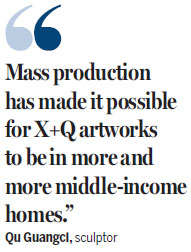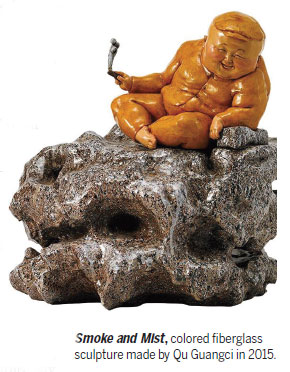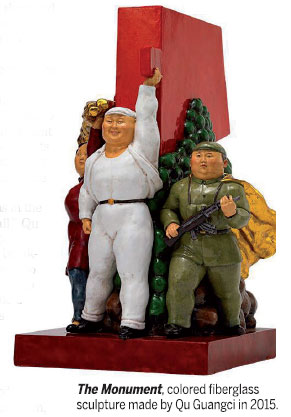
Mixing evocative tradition with the palyfully new to create a global commerical success
Andy Warhol famously said, "Business art is the step that comes after art," precisely predicting the integration of art and business in today's world.
Qu Guangci, China's reputed contemporary sculptor and artist, believes art, which has traditionally been put on a pedestal by ordinary people, has been deconstructed into symbols that are integrated into the daily lives of the modern-day consumer society and is getting closer to people's innermost emotions.
As the founder and artistic director of the design brand X+Q Art, Qu received the Brand of the Year award from the China General Chamber of Commerce-USA on Jan 19 at the Waldorf Astoria New York hotel.
"China, as a country under such a speedy development, is longing for a high-end contemporary art brand to challenge or to face the challenge from established international design brands," Qu said in an interview with China Daily.
Founded in 2010 in Beijing by Qu and his wife Xiang Jing, also a leading sculptor in China, X+Q Art (the name is an abbreviation of Xiang Jing + Qu Guangci) offers limited-edition handcrafted sculptures, accessories and design products.
Emphasizing the concept of "art gift", X+Q Art tries to deliver the wish of happiness, love and affection through a gift.
Qu believes X+Q Art has two commercial advantages: First, the brand features a strong modern spirit.
"We keep rethinking how to explain the deep emotions of modern Chinese and try to transfer that modern social language into the artworks, which made our products more extensive," Qu said.
Second, "innovation is our brand's main characteristic", Qu explained. "We believe it has a sustainable space in its field."
X+Q Art products resonate with Chinese - whether in China or abroad - by connecting with their emotions, Qu said. "We are not merely digging out some basic symbols from tradition, but hoping X+Q Art can produce its fruits in the future based on the emotional aspects of Chinese culture, then we can say we create a new value," he added.
Born in Shanghai in 1969, Qu received his master's of fine arts from China Central Academy of Fine Arts Sculpture Department.
As the youngest artist to win the grand prize at the National Fine Arts Exhibition at the age of 25, Qu became known throughout the art world for his innovative sculptures, contemporary language and expression techniques. He is most famous for his Little Fatty series.
Since 1999, Qu has been invited to exhibit his artworks around the world, including China, Germany, France, the US and Southeast Asia. To date, he has held nine solo exhibitions.
Resigning from their teaching positions at Shanghai Normal University together in 2007, Qu and his wife founded X+Q Sculpture Studio to devote themselves to creating artworks fulltime. They established the X+Q Art brand in 2010 and currently live and work in Beijing.
Industry commentators have said that Qu's work suggests a dual nature.
"Many of his artworks present a balanced state between humanity and divinity," a description on the website Artspace reads. "They are neither angels nor demons, neither conflicted nor hesitant - its significance is a reflection of the current state of affairs in China."
As one of the most active contemporary Chinese artists collaborating with other creative disciplines, Qu has been praised for his ability to combine tradition with modern, culture and design, art and commerce, all with the right balance.
Xiang Jing believes Qu's personality breaks through the stereotype that artists are bad at brand management, giving their products a unique style blending art, design and commerce.
X+Q Art has gained popularity in a relatively short time by partnering with show business, high-end department stores, luxury hotels, design galleries and museum stores. "X+Q was able to develop so quickly because China's soil is very eager for this seed," Qu said.
"The world has always admired the glory of ancient Chinese civilization, but it's kind of hard to see China's modern value being exported to the world," Qu said.
Ma Jidong, a senior Chinese art critic, wrote in a column that the banners of commercial art have been raised continually no matter by Andy Warhol in the US or Damien Hirst in the UK since the end of World War II.
Ma believes behind the prosperity of the market for limited edition designs, design replicas and design derivatives is ordinary peoples' desire to buy art and make it part of their lives.
"There is no doubt that commercial art will be the next stage of the art experience in China," Ma wrote.
"An art derivative is like a beautiful lifebuoy that saves you from the rough seas of business," Qu wrote in his diary. Qu was fascinated by the art derivatives sold at the Museum of Modern Art in New York and bought a boxful to China.
X+Q's target consumer is one of the most overlooked groups in China - the white-collar worker with a salary of 5,000-15,000 RMB ($830-$2,500). "Mass production has made it possible for X+Q artworks to be in more and more middle-income homes," Qu said.
"The success of Starbucks inspired me a lot," Qu said. "No matter you are a college student or a billionaire, you drink Starbucks. It's the same with art. Everybody has the right to enjoy it."
X+Q's brand positioning has become more accurate, especially with home accessories. "In 2016, our brand will be further improved to serve more people," Qu said.
In 2012, X+Q broke into New York's Guggenheim Museum gift shop and in 2013, X+Q products were recommended by the BBC on a list of Christmas gifts.
Last September, X+Q became the first Chinese art brand invited by Maison & Objet (M&O), the major Paris trade fair for interior design, to exhibit. As one of the most important European - even world - events for interior design, there was barely a Chinese brand to be found there over the past 20 years.

"We exhibited our designs in the front row of the main hall," Qu recalled, his eyes lighting up.
"That was an important breakthrough for not only X+Q but also Chinese art brands trying to do business overseas," Qu added. The number of overseas business opportunities he acquired during the fair exceeded the total number he had from China earlier.
Apart from stores located in Beijing, Shanghai and Shenzhen, X+Q art derivatives sell in Lane Crawford department stores, the Langham, Tuantuan Boutiques, the Guggenheim Museum, the Victoria & Albert Museum and Entratalibera in Milan. The company also has distribution channels in Europe, America, Hong Kong and Taiwan.
"Some in the industry overseas still remain skeptical or concerned that Chinese art brands may be more like copycats rather than innovations," Qu said. "It's somewhat difficult," Qu said. "The cultural differences, the price differential are both obstacles for the brand. But nevertheless, we must take the leap."
During his acceptance speech for the Brand of the Year award in New York, Qu said, "The peaceful rise of a country would be simultaneously accompanied by the development of influential enterprises and brands of that country.
"Culture is a country's soft power. I wish in the future, foreigners will not only recognize Bank of China, China Petroleum or China's Alibaba, but also a brand called X+Q Art," Qu added.
xiaohong@chinadailyusa.com


|
X+Q Art in Design Shanghai. |
|
Qu Guangci, China's reputed contemporary sculptor and artist with his artwork Rainbow Angel. |
|
Qu Guangci works on the group sculpture Knife Gang. Photos provided to China Daily |